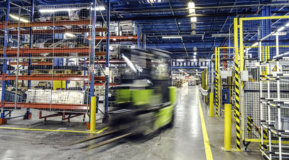What is the Circular Economy?
The Circular Economy decouples economic growth and development from the consumption of finite resources. It aims to keep products, components and materials at their highest utility and value at all times, and eliminate waste across a product’s lifecycle through superior design and reuse.

The rise of e-waste and urgency for change
Digital advancement, in conjunction with rising disposable incomes and industrialization in developing countries, has caused an explosion of e-waste. It has become one of the world’s fastest-growing waste streams and is taking a toll on our planet.
The problem is only growing. Emerging technologies like AI and blockchain will require an enormous amounts of compute power and technology to reach their imagined scale — outpacing our energy, space and material resources.
This rapid pace of innovation in IT is increasing the need for a Circular Economy.
Circular Economy can help you re-think the value of aging IT infrastructure
This year, the amount of e-waste generated around the world is expected to be about 50 million tons. IT has been a big part of that. Consider this – the number of transistors and resistors on a computer chip doubles every 24 months. And that’s good from a processing power perspective, but do you ignore the waste that amasses in the wake of that innovation? That’s what too many business are thinking – that endless progress is only bought at the cost of continually throwing out old hardware.
That old way of thinking is not a sustainable proposition – for business, for culture, or for the planet.
We need to think about it differently. We need to turn the old way of thinking about aging IT infrastructure on its head. And that is where the Circular Economy comes in.
The Circular Economy is a way to help IT achieve both business and sustainability goals.
By thinking about your infrastructure in new ways, you can build strategies to extend and extract value from what you have, and you can also use retired assets to help fund the transition to new infrastructure.
Incentives to act
When it comes to the incentives to participate in the Circular Economy, the benefits go beyond just the “right thing to do” for the environment.
- Best Practices: Sustainability initiatives in IT are becoming more and more important to customers, investors and employees. People care about the environment and want to purchase from, work for, and invest in businesses that do, too. And they care about working with supply chain partners who think about both the upstream creation of products, and the downstream impact at end of use.
- Economic Opportunity: Youcan still keep up with the pace of change while participating in the Circular Economy — and gain an economic advantage in the process. When upgrading IT, many organizations remarket and resell their unneeded equipment to return money back to their IT budget — a strategy that can pool money into innovation and help extend the life of functional assets.
- Compliance and Regulations: Official policies and legislation on the proper disposal of technology has become increasingly adopted around the world. Not being compliant can be devastating for a company’s bottom line and brand reputation. Improper disposal settlements have reached into the millions of dollars. And hefty fines aren’t the only risk — sensitive data like customer or employee information left on discarded technology can result in data breaches.
Support the Circular Economy with Upcycle to the Edge
The new Upcycle to the Edge offer helps you transition to a new Aruba solution while supporting a Circular Economy and minimizes the complexities of removing your existing networking equipment. In addition, you may receive value for your old equipment to go towards your new solution, and you’ll get the flexibility to defer payments or make small, minimum payments during your installation rollout for up to 12 months. Learn more.
Learn more
Circular Economy, IT Asset Lifecycle Solutions, and contact HPE
Ebook: The Circular Economy in IT
Watch the video: Upcycling for the Bottom Line




